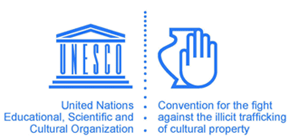 By invitation of UNESCO, the Secretary-General of CITES, Mr John Scanlon, attended the 40th anniversary of the 1970 Convention for the fight against the illicit trafficking of cultural property*, in UNESCO Headquarters, Paris, on 15 March, 2011.
By invitation of UNESCO, the Secretary-General of CITES, Mr John Scanlon, attended the 40th anniversary of the 1970 Convention for the fight against the illicit trafficking of cultural property*, in UNESCO Headquarters, Paris, on 15 March, 2011.
The aim of the event was to evaluate and reinforce the Convention’s effectiveness and to elaborate strategies to improve its implementation with regard to new trends in illicit trafficking in cultural heritage. The CITES Secretariat was requested to share its experiences in combating illegal trade and in implementing and promoting the Convention.
The Secretary-General of CITES noted several similarities between the two Conventions, including the categories of cultural property being defined to include “rare collections and specimens of fauna [and] flora” and the preamble to CITES, which recognizes the “value of wild flora and fauna from aesthetic, scientific, cultural, recreational and economic points of view”. He highlighted the following aspects of CITES, which have contributed towards its successful implementation since being adopted in March 1973:
-
The level of national ownership of the Convention, with CITES Parties being obliged to establish at least one national Management Authority, and Scientific Authority, and to put into place domestic legislation and enforcement measures. These authorities exist across 175 Parties and are core to the success of the Convention in ensuring that international trade in CITES specimens is legal, sustainable and traceable. The Convention deals with both legal and illegal trade. Well over 10,000,000 trade transactions regulated under CITES have been reported over the past 35 years.
-
The national CITES authorities take steps to promote and raise awareness of the Convention (such as what you will often observe at international airports), and it is they who drive national level implementation of the Convention.
There is also recognition that illegal trade in wildlife robs countries of their natural and cultural heritage, local people of livelihoods and government of revenue.
-
The inclusion of effective compliance measures under CITES, involving the the Conference of the Parties, and its three permanent committees as appropriate, enables compliance issues to be openly addressed and measures to be taken in response to non-compliance.
-
Under the Convention this can, as a last resort lead to a recommendation to suspend trade. This has happened on a number of occasions, with such suspensions being in place in relation to over twenty countries today, mostly in relation to the trade in specified species. The Secretariat works with Parties that are subject to a recommendation to suspend trade to assist them in coming back into compliance, for which we currently receive generous financial support from the European Community.
-
Having a dedicated, technically capable Secretariat to respond to the requests of the Parties in a timely and dedicated manner. This includes, by way of example, having a Chief of Enforcement with 24 years of experience with the Scottish Police Force before joining the Secretariat. He is from the enforcement world and as such can easily relate to the culture of this field of work.
-
The strong interest of the non-governmental sector in the implementation of the Convention – with a wide-range of organizations taking a close and active interest in the Convention from many perspectives. This includes both international and national organizations from across the globe.
-
The ongoing targeted capacity building initiatives aimed at assisting in-country implementation of the Convention, working with CITES authorities and Customs, police and wildlife enforcement officers.
-
This includes a dedicated master’s level course conducted by the International University of Andalusia, Baeza, Spain, which has educated well over 200 students from over 60 countries in CITES, many of whom now work in CITES Management and Scientific Authorities. CITES will also launch a web-based Virtual College in a few months time, offering a number of courses and training materials on a wide-range of relevant topics, to be hosted by the University of Andalucia.
Capacity building also includes participation in the Green Customs Initiative, which brings together many multilateral environmental agreements with Customs officials. And CITES conducts targeted capacity building where consumers and producers are brought together to address sustainability and compliance issues, as was done recently with medicinal plants and saiga antelope and as will be done with snakes next month.
-
Strong and effective partnerships with a focus on delivering results – such as our partnership with the international enforcement community through the International Consortium to Combat Wildlife Crime (ICCWC), which was formally launched in Saint Petersburg last year at Prime Minister Putin’s Tiger Summit. This is a consortium of Interpol, WCO, UNODC, The World Bank and CITES that is dedicated to fighting wildlife crime by drawing together the vast and complementary expertise of each organization.
-
Effective implementation of CITES relies upon these partnerships – and in particular the role of partners such as WCO and Interpol and the in-country Customs and police officers who stand at the front line of implementation.
This is a very brief overview of some of the measures that have been taken to advance the effective implementation of CITES. They are offered as a comparative example of what is being done under another Convention that faces similar implementation challenges.
“There is great value in sharing experiences amongst Conventions and organizations. We have certainly learned from the 1970 Convention and trust that sharing our experiences over 35 years has been of some value to colleagues in UNESCO as well,” concluded CITES Secretary-General, John Scanlon.
*Convention on the Means of Prohibiting and Preventing the Illict Import, Export and Transfer of Ownership of Cultural Property